If you’re looking for ways to better organize the onboarding process in your organization with Microsoft Teams templates, you came to the right place. In this blog post we will go through the main template capabilities that will help you make sure your new hires are successfully onboarded and explain how to build an Onboarding template.
But before we do, let’s understand why you need to use Microsoft Teams onboarding template in the first place.
Why do you need a Microsoft Teams onboarding template?
Structured onboarding process
To make sure your new hire onboards successfully, the best practice is to create a dedicated space where they could get access to all the necessary information and tasks. For that, you will need to create a separate Onboarding team for each new employee. At the same time, you want these teams to have a similar format to bring consistency to the onboarding process.
Having a Microsoft Teams onboarding template allows you to achieve just that. You will only need to create the original onboarding team once. Then you add all the required channels and content, and use it as a template. All the teams created from this template will contain the content you added into the original team.
Less workload for HR, managers, and IT
Having all the information ready at place whenever you create a new Onboarding team means that your HR and respective managers don’t need to spend extra time searching for and preparing the onboarding material. Additionally, with template governance policies you won’t need to ping your IT department for a permission to create new teams.
Improved employee experience
Your new hires will also highly benefit from having a fully provisioned team that provides them with all the necessary tools for successful onboarding. They will be able to start their journey straight away and have a clear idea about what they need to do and empower them to merge into their new role much faster.
→Download White Paper: How to Use Microsoft Teams for Onboarding – Best Practices
Microsoft Teams Collaboration template capabilities
Now let’s go through key capabilities of Microsoft Teams Collaboration templates that you could leverage for the onboarding process.
What will you get?
Pre-built channels
Depending on the size of your organization, you may want to have only one or several Onboarding templates. For example, it can be one for each branch or department in your company.
You can build channels that will help guide your new hire through the onboarding process. For example:

- Our Company
- Meetings and Events
- Training
- Documentation
- Security
- Team
Having distinct channels for each topic that you want to cover during the onboarding will allow your new fire to navigate easily through the process and find the right information faster.
Files and tabs
You may want to provide your new hire with all the necessary content to help them get familiarized with the company and their new role. To do so, upload the right files in respective channels and pin the most important ones as tabs.
If you have training videos you can upload them in Stream and add it as a tab in your Training channel. You can also create an Onboarding SharePoint site where you can share latest news, resources, and general information about the company and its culture.

Onboarding tasks
The key to successful onboarding is having a clear understanding of what you need to do and how to do it right. You’ll save your new hires and yourself time and nerve if you take the time to prepare an onboarding plan. Microsoft Planner is a wonderful tool to do that.
With Planner, you can create buckets with different tasks, add checklists and attachments for each task, leave comments, set priority levels, add labels, and track their progress.
Here are some bucket examples:
- Our Company
- Our Product
- Your role
- Competitors, etc.
Then create tasks with a checklist accordingly that would correspond to each bucket.
Let’s take an example of Learn about our work culture task. You may add the following elements as a checklist:
- Vision and mission
- Values
- Working style
- Working schedule and holidays
- Teambuilding events, etc.
To help your new hire quickly find this information, you can attach links to your company’s web pages or other resources.
Here are some examples of tasks that we had when we onboarded SalesTim:

Pro-tip: It will be a good idea to let your new employees organize their own onboarding process and allow them to set priorities for tasks on their own. Just make sure you set your expectations clear about the workload and deliverables.
Organized agenda
In the Meetings and Events channel, you can add a Calendar tab. Use it to schedule recurring daily or weekly 1:1 meetings with your new hires to support them in the onboarding process. This way, they will always stay up to date regarding their schedule and prepare all the critical issues in advance.
Having these regular 1:1 meetings is critical during the first weeks of the onboarding process. It is important to make sure your new employee shares their feedback and have all their questions answered in a timely manner. It is also a good idea to organize weekly team meetings to help your new employee get to know everyone better and develop the feeling of belonging to the team and to the company.
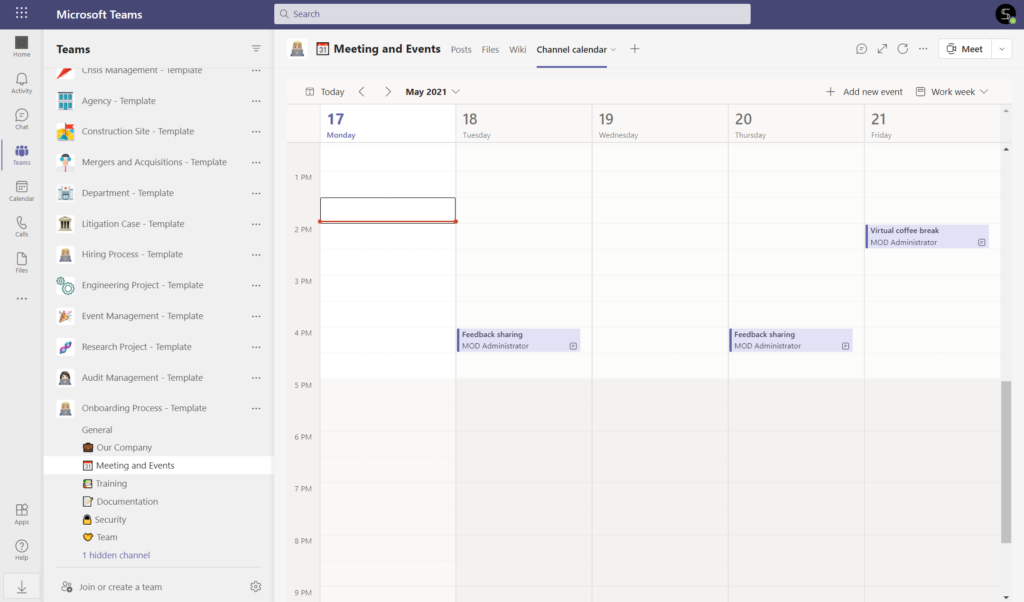
Get the right people onboard immediately
Collaboration template governance policies allow you to assign Permanent owners and members to your team. This way, each time you create a new Onboarding team from the template, specified people will be automatically added to the team.
For example, you can add your HR manager as a Permanent owner so that he or she could invite other users to the team.
Accessible to specific people
You can also control who get’s access to a particular template. This is a great way to restrict users from creating teams that contribute to teams sprawl. For example, you can make sure only members of your HR department and department managers can access your Onboarding template and create new teams from it. As a result, it will not be visible to other users in your organization.
Communicate to the entire organization with Yammer
If you work in a large organization, chances are you use Yammer alongside Teams. This platform connects employees across the entire organization and can be proven useful for your new hires. Through Yammer communities they can get to know other specialists from their own field, share their knowledge expertise, and ask for professional opinion of their colleagues.
It might also be a good idea to connect your new hires with other employees who have been recently recruited. This way, they can share their experience, exchange best practices, and learn more about the company.

Integration with 3rd party apps
Depending on the job role of your new hire and your organizational needs, you may want to integrate a 3rd party app into your Onboarding teams. For example, if your organization uses a project management tool such as Trello or Asana, your can add it as a tab in your Onboarding template. This way, your new hire will learn how to use the app during the onboarding without leaving the Teams environment.
Answering the IT needs
Collaboration templates also allow you to configure governance policies that answer specific needs of your organization. Let’s list some of the key governance capabilities.
Define naming rules
You can make sure your Onboarding teams follow the same naming rules by implementing a Naming convention at the template level. You can choose static or dynamic naming convention based on Azure AD attributes, for example:
Name of the user – Onboarding
Or
Onboarding – Name of the user – User location
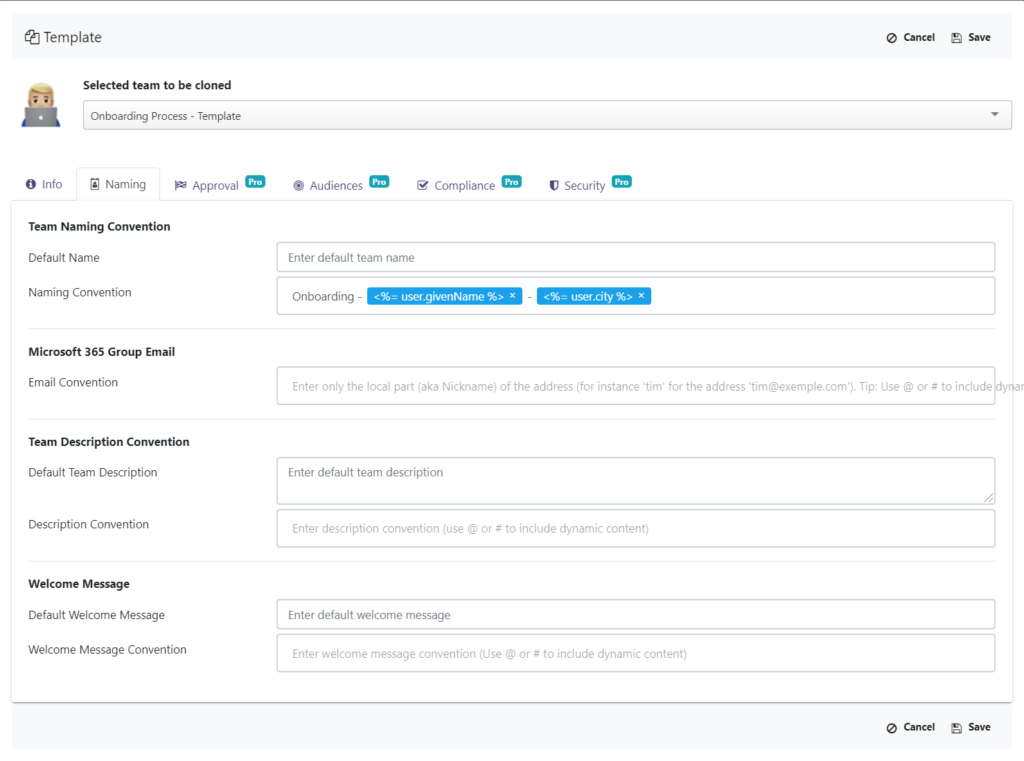
Determine who can use your template
By enabling Audience targeting you can ensure your template will be visible to a limited group of people. For example, with the Onboarding template, you can configure Audience targeting only for your HR department. This way, the template won’t appear in your Template catalog for the members of other departments.
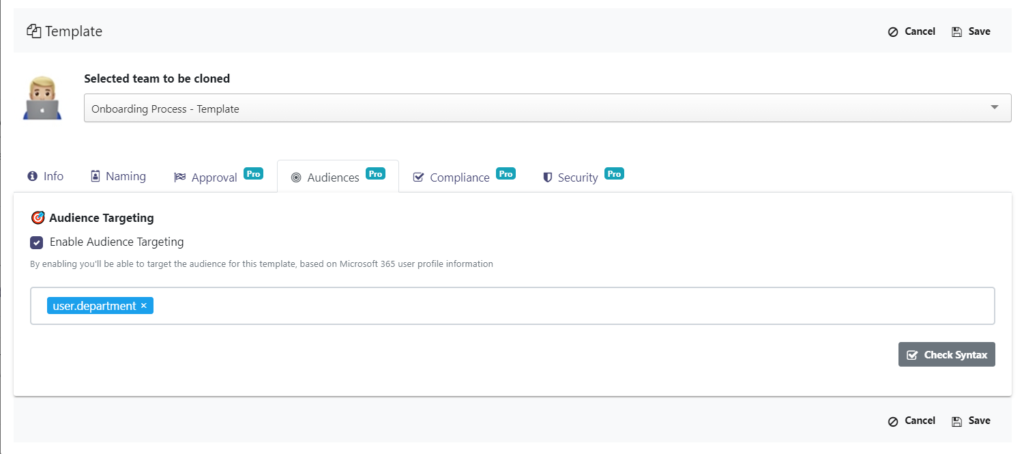
Add Approval workflow
If you want to further control the team creation process for onboarding, you can assign specific people as approvers at the template level. This way, each time someone wants to create a new team from this template, they will first need to get an approval from specified users.
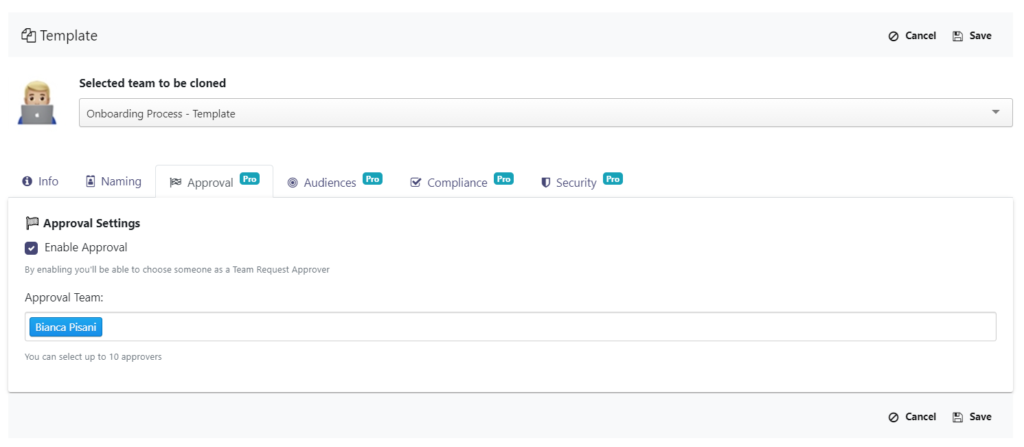
Manage membership policies
Additionally, you can add your HR managers or managers of respective departments as Permanent owners and members of your Onboarding template. Consequently, when a new Onboarding team is created, they will be added there automatically.
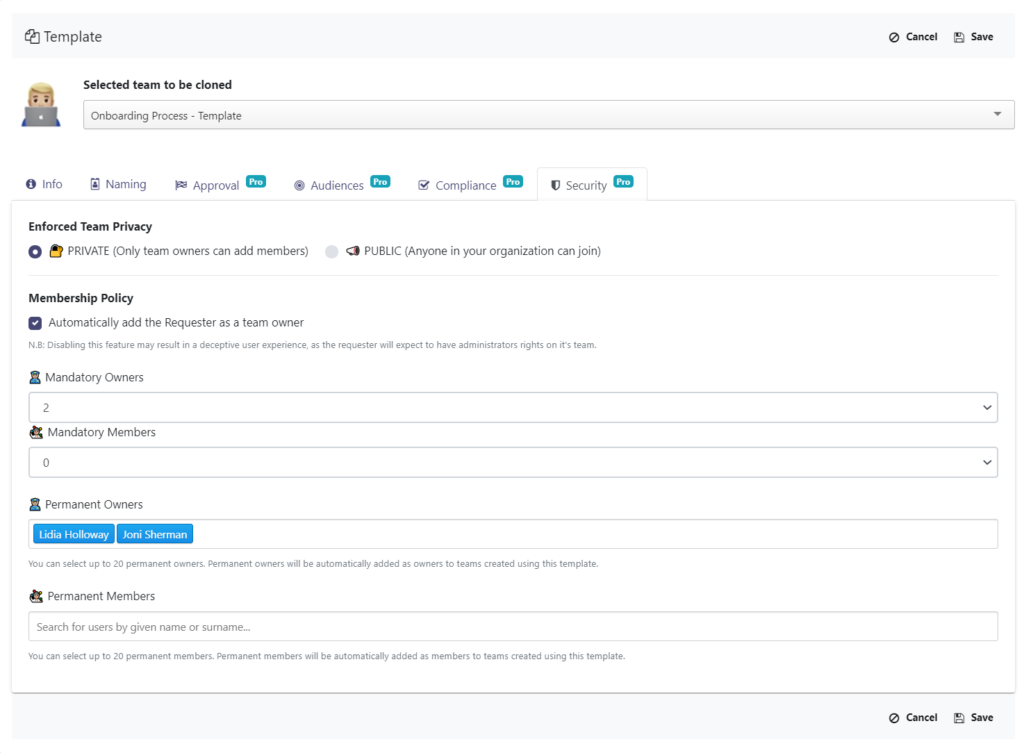
Automation with Power Automate
With Power Automate you can save time on performing routine tasks by automating the process. By using Microsoft Teams connector in Power Automate, you can set up triggers to create new teams and channels, set up notifications and approvals, etc.
Let’s see how you can leverage Power Automate for the onboarding process.
Automated emails to help onboard a new hire
Imagine, your new hire has never used Microsoft Teams before and is not familiar with the purpose of channels, tabs and apps that are integrated within.
To help them get the gist, you can set up automated emails with step-by-step guidelines explaining how to navigate through the Onboarding teams and where all the key information is stored.
Integrate your 3rd party app with Power Automate and SalesTim
With SalesTim connector, you can add triggers from 3rd party apps for managing Microsoft Teams. For example, you can connect your HR app to Power Automate so that and each time a new hire is added to the app, a new team will be created from the Onboarding template.
If you’re using Trello for managing your employees, you can set up a trigger “When a new card is added to a list” and then choose an action with SalesTim connector “Create a new team based on a template”.
Learn more about Power Automate and Microsoft Teams templates.
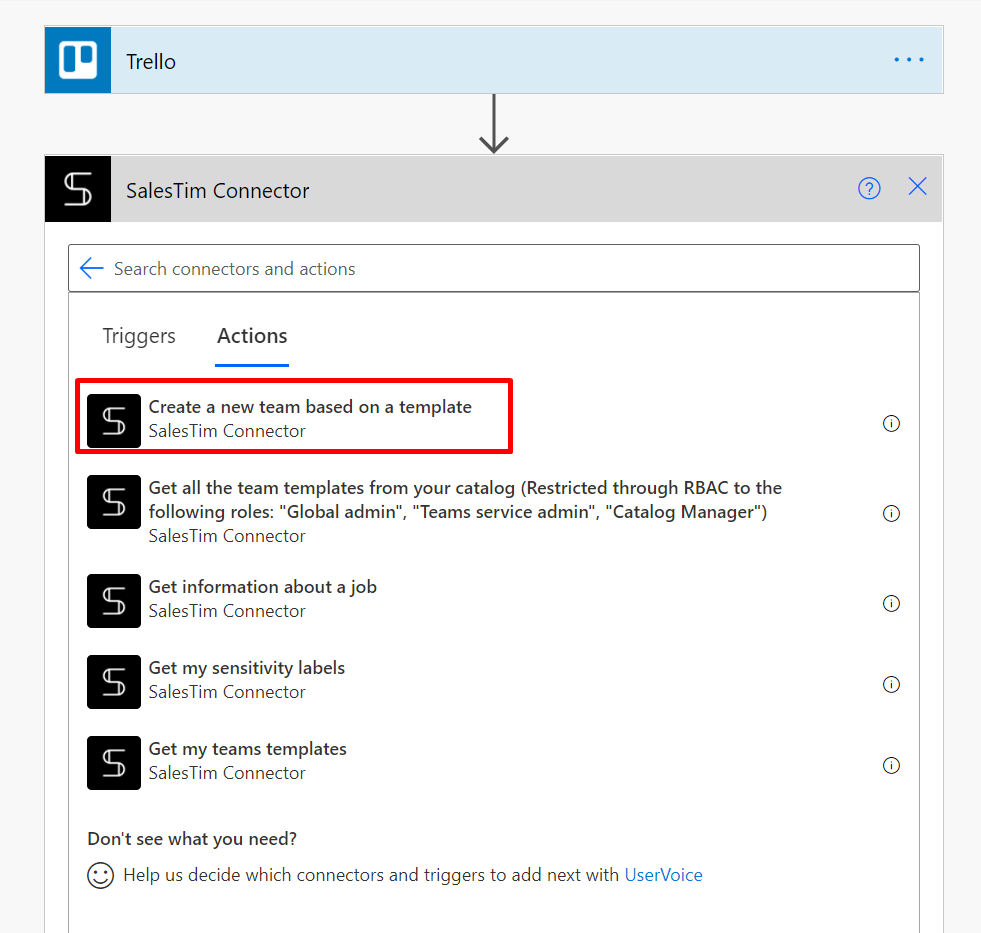
How to build a Microsoft Teams Collaboration template?
In order to build Microsoft Teams Collaboration template, you will need to install nBold app from Microsoft Teams store. You will need to have admin rights to manage it.
- Create an original team for the onboarding process with all the channels, files, tabs and all the required content. You can call it the Onboarding – Template.
- In the nBold tab on the left bar of your Teams window, click on Catalog, then +New template.

3. Type the name of your original team “Onboarding – Template“.
After you select the right team, you will see a window asking you to configure governance policies.
4. Define a Naming convention, Approval workflow, Audience targeting and Security policies. Then, click Save.
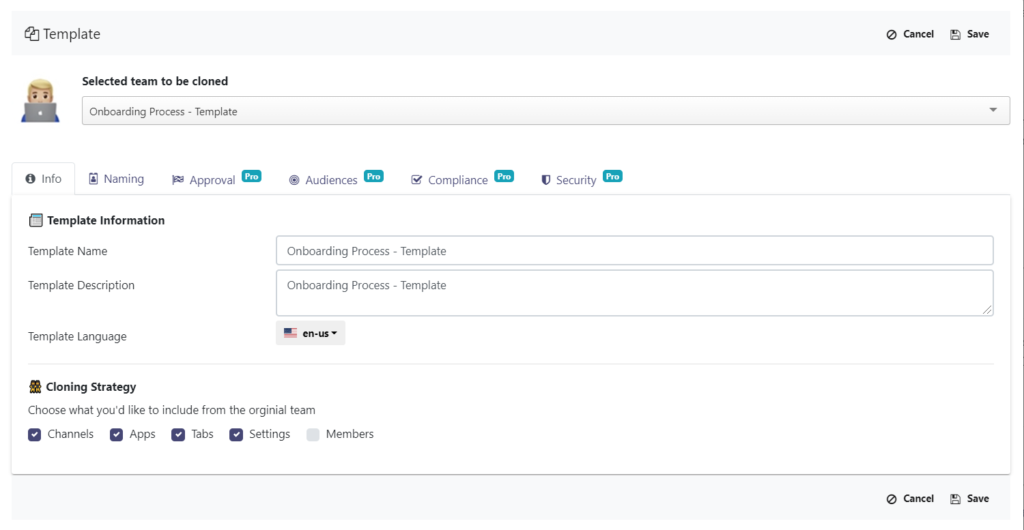
That’s it, the template is done! It will be added to your Template catalog that your users can use to create new teams.
In order to create a new Onboarding team, your users should head to the Home tab, then select +New team, and choose the right template from the Template catalog. All the content contained in the template will be automatically added to new teams.
Want to learn how to implement a Collaboration template for your business needs? Book a meeting with us and we’ll help you find a solution.
